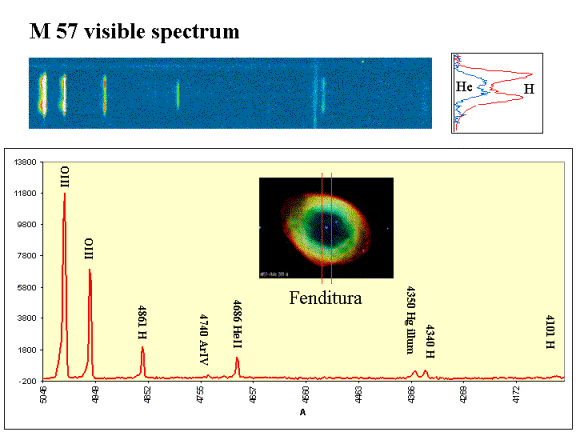THE SPECTRA OF NEBULAE
Planetary
- Diffuse
The spectrum of planetary nebulae
The origin of the spectrum of planetary and diffuse nebulae is the same.
The intense UV radiation of the white dwarf ionize hydrogen atoms and the other gases
of the nebula that generate fluorescence when recombining with free electrons.
Thus the same forbidden oxygen and nitrogen lines ca be observed in both diffuse and
planetary nebulae but in the latter the intensity of heavier elements is higher due to
previous nucleosintesys of the once-existing star.
The central stars are extremely hot, with temperatere that ranges from 25000 to
250000 K and show often a Wolf-Rayet type spectrum rich of carbon or nitrogen.
In other cases these stars show some absorbtion bands and then they are classified in
the O class ( O Subdwarfs ).

|
Picture 1: Blue-green spectrum of M57 taken with 900 l/mm f=50 mm spectrograph, 5 minutes exposure with CCD
detector.
The slit cross the nebula as it is shown in the picture of M57. Intensities of spectral lines changes from
the middle to the edges. Emission from doubly ionized Helium is stronger in the middle (probably due to higher
temperature), while oxigen and hydrogen appears mainly at the edges.
Note the presence of lines from the heavy
element Argon (Z=18 that is not visible in M42 spectrum) and stronger intensity of Oxygen lines compared to
Hydrogen than in M42 spectrum.
|
The measure of temperature of central stars in planetary nebuale is calculated with the
method proposed by Zanstra. All the radiation emitted from the star between the Lyman
limit (912 ┼) and the He II Lyman limit (228 ┼) is used for the ionisation of hydrogen
atoms in the surrounding nebula. Recombination of free electrons with hydrogen atoms
produces Lyman and Balmer lines and continuum. Lyman lines are converted into visible
lines by oxygen and nitrogen that produces the well known forbidden lines.
Thus, measuring the total visible emission of the nebula it is possible to know the
total UV emission (between 912 and 228 ┼) of the central star. Comparing its UV emission
with its brightness in the visible can be computed the temperature assuming a blackbody
spectrum emission.
Goto other nebulae:
Emission Nebulae
|
|

